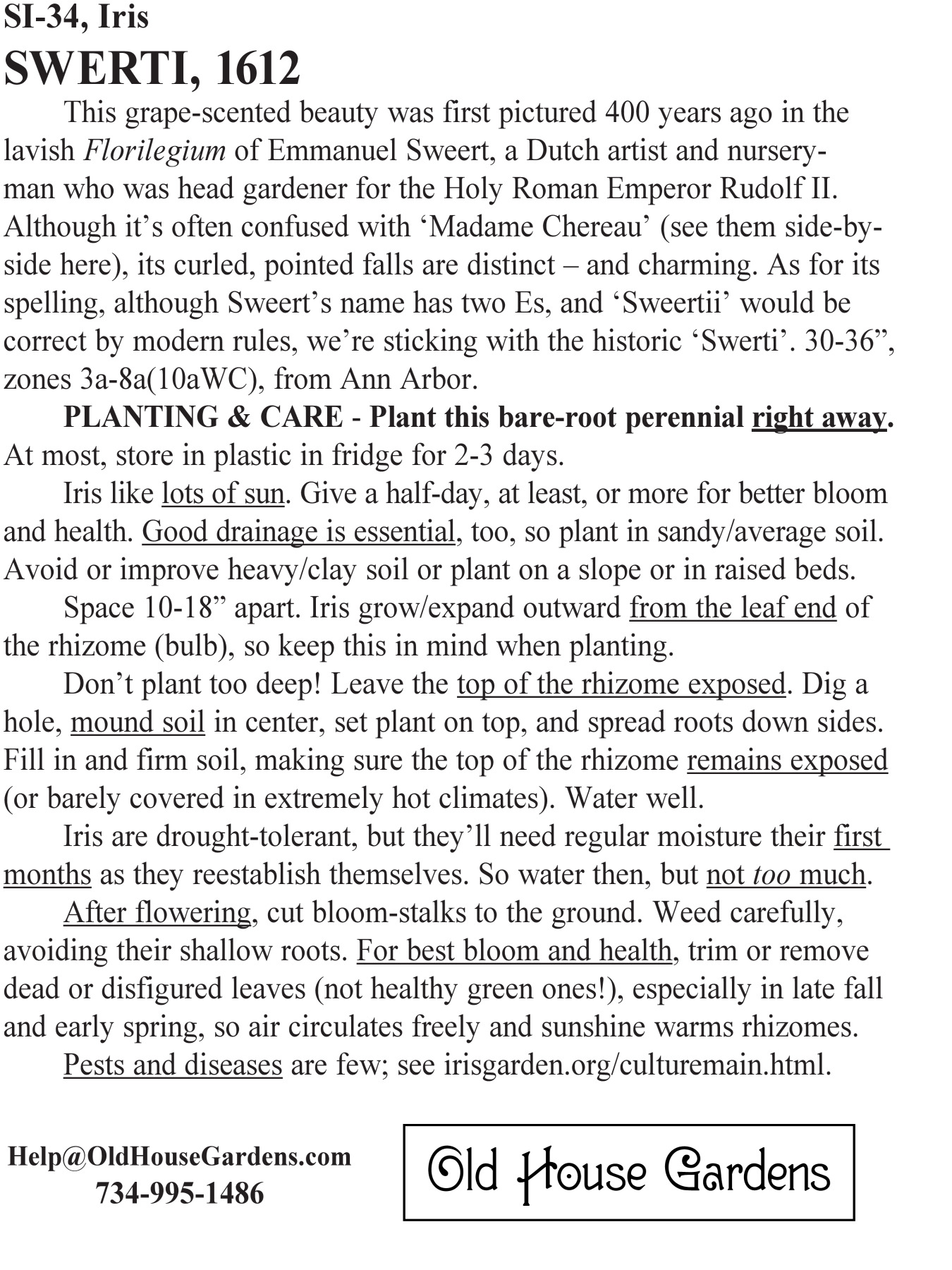|
|

 
|
|
This grape-scented beauty was first pictured 400 years ago in the lavish Florilegium of Emmanuel Sweert, a Dutch artist and nurseryman who was head gardener for the Holy Roman Emperor Rudolf II. Although it’s often confused with ‘Madame Chereau’ (see them side-by-side here), its curled, pointed falls are distinct – and charming. As for its spelling, although Sweert’s name has two Es, and ‘Sweertii’ would be correct by modern rules, we’re sticking with the historic ‘Swerti’. 30-36”, zones 3a-8a(10aWC), from our own micro-farm. Summer shipped, click here for spring shipped. |
|
SUB TYPE American, bearded, plicata, German, flag, flags, grape ZONES 3a-8a(10aWC) HEIGHT 30-36” SOURCE America, Michigan, Ann Arbor LIGHT full sun |
PLANTING & CAREUnlike most sources, we ship our iris as bare-root plants in the spring. (See an example here.) Plant them right away. They’re freshly dug, can take light frost, and to bloom their first summer they must get growing again ASAP. If necessary, store in the fridge for 2-3 days or “heel in” briefly in moist sand or soil. Iris like lots of sun. Give them half a day, at least, or more for increased bloom and better health. Good drainage is essential, too, so plant in sandy to average soil. Avoid or improve heavy (clay) soil or plant on a slope or in raised beds. Space 10-18 inches apart. Iris grow/expand outward from the leaf end of the rhizome (bulb), so keep this in mind when arranging and planting them. Don’t plant too deep! Leave the top of the rhizome exposed. Dig a hole, mound soil in the center, set plant on top, and spread roots down the sides of the mound. Fill in and firm soil, making sure that the top of the rhizome remains exposed (or barely covered in extremely hot climates). Water well. Though iris are drought-tolerant and will rot in soil that’s too wet, they’ll need regular moisture the first few months after planting as they reestablish themselves. So water them, but not too much. Let your green thumb be your guide. After flowering, cut bloom-stalks to the ground. Weed carefully to avoid damaging shallow feeder-roots. For best bloom and health, trim or remove dead or disfigured leaves (but not healthy green ones!), especially in late fall and early spring, so air can circulate freely and sunshine can warm the rhizomes. After a few years of vigorous growth, your iris may get so crowded that their bloom and health begin to suffer. To thin or divide them, wait 4-8 weeks after bloom and then either open up the clump by removing the oldest rhizomes from the center, or dig it all, replant the best new rhizomes, and give away or destroy (don’t compost) the others. Iris have relatively few pests or diseases that trouble them. For helpful advice on the most common ones — iris borer (which is only a problem east of the Rockies), leaf spot, and root rot — see the excellent Iris Garden website sponsored by the iris societies of New England. Learn more about growing and enjoying iris at our Iris Newsletter Archives and Bulbs as Cut-Flowers page. |

|
SPRING
|
· |
SUMMER
|
· |
FALL
|
· |
LEARN MORE
|
· |
ORDERING
|

|










